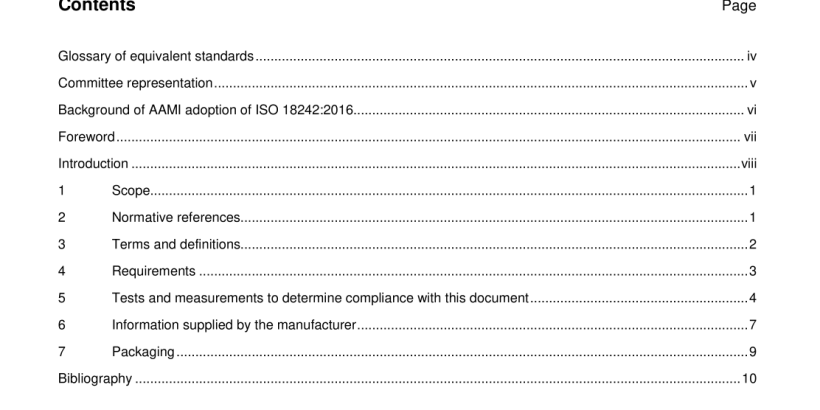ANSI AAMI ISO 18242-2016 pdf download
ANSI AAMI ISO 18242-2016 pdf download.Cardiovascular implants and extracorporeal systems—Centrifugal blood pumps
5.4.1.1 Test liquid
The test liquid shall be a blood analogue or anticoagulated blood, and its composition and viscosity (measured at the same temperature as the hydraulic performance testing) shall be indicated.
5.4.1.2 Procedure
Place the device under test in an appropriate test circuit. Perform the testing at 37 °C ± 1 °C or at typical temperature, viscosity, and hematocrit of blood during intended clinical use. Set the r/min of the pump. By varying the restriction on the outlet tubing, measure the pressure differential between the inlet and outlet and the corresponding flow rate. Construct a plot showing the pressure differential versus flow rate for multiple r/min settings over the entire rated operating range of the pump (up to the maximum r/min).
5.4.2.2 Procedure
Two sets of appropriate circuit components (including a pump in the test circuit and a predicate pump in the control circuit), connecting tubing, and a reservoir (as specified by the manufacturer and of suitable size relative to the device under test) shall be assembled. Priming and debubbling of the circuits by recirculating with an appropriate solution is recommended before blood is added. The test liquid volumes shall, at the initiation of the test, be within 1 % of each other. Perform the test using the maximum rated flow rate of the device and obtain blood samples at least at the following time points: prior to test, 30 min, 180 min, and 360 min. More frequent sampling times are optional. For each sample, measure the following: plasma-free hemoglobin, white blood cell, platelet counts, activated clotting time, temperature, and flow rate. Glucose should also be measured prior to the test. A sufficient number of paired tests should be performed to support a statistical analysis. The predicate pump should be tested under the same conditions regarding flow rate, preload, and afterload.
5.4.3.1 Test liquid
The test liquid shall be a blood analogue or anticoagulated whole blood.
5.4.3.2 Procedure
The worst case conditions for bearing wear should be identified. Set the pump speed at the maximum r/min at a clinical relevant back pressure. Operate the pump for a minimum of 6 h or as specified by the manufacturer’s instructions for use and measure the flow output of the pump for the duration of the test. Assess the extent of wear on the bearing.
5.4.4 Shelf life
Using a validated method, ageing should be performed on final, finished, sterilized devices in primary packaging in order to determine nominal shelf life.
6 Information supplied by the manufacturer
6.1 Information on the device
The following information shall be given on the pump:
a) the manufacturer’s identification;
b) batch, lot or serial number designation;
c) model designation;
d) the direction of blood flow, if necessary.
A bar code or other system of identification may be used; considerations for visibility of the blood flow pathway should be considered.
6.2 Information on the packaging
6.2.1 Unit container
The following shall be visible through or given on the unit container:
a) the manufacturer’s name and address;
b) description of contents;
c) model designation;
d) statement on sterility and non-pyrogenicity;
e) expiry date;
f) batch, lot or serial number designation;
g) the words “Read instructions before use;”
NOTE 1 The approved symbol can be added before “Read instructions before use.”
h) any special handling or storage conditions;
i) statement on single use.
NOTE 2 The approved symbol can be added before the words “Do not re-use,” “Single use,” or “Use only once.”
